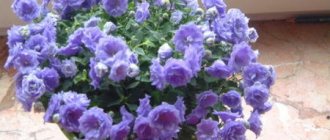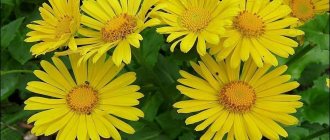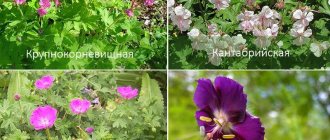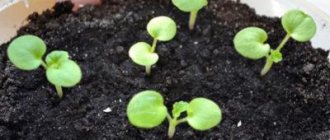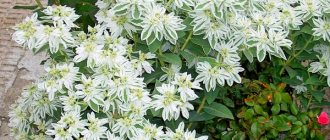Garden daisies are especially popular among Russian flower growers and landscape designers. Their popularity is explained by their visual appeal, unpretentiousness and medicinal properties. Anyone can grow a flower in their own garden plot or flower garden near their home; it is enough to know the basic rules for caring for the crop.
A distinctive feature of perennial garden chamomile is its huge buds.
Features of the flower
There are a large number of varieties of garden chamomile. Each representative of a culture has its own characteristics and external differences. But there is also a unifying feature, which is expressed by an inflorescence in the form of a basket with a yellow core and snow-white petals. The exception is colored hybrids.
Garden crops differ from their wild counterparts in the following ways:
- large buds;
- abundant and long flowering;
- the possibility of re-ovarying inflorescences.
The perennial plant belongs to the Astrov family; it stands out from its fellows with a thin stem that can reach 60 cm in height.
Bipinnate leaf plates are arranged alternately on the shoot. And at the very top there are large flowers, the size of which varies between 10-15 cm.
The distinctive features of garden chamomile are its rapid development and growth, early bud formation and long flowering, which lasts from mid-June to the end of summer.
Breeders managed to develop chamomile with semi- and double flowers, in which the petals are arranged in several rows, they look like balls
Preparing Leucantemella for winter
In general, Leucantemella does not require practically any preparation for winter: only regular pruning of the stems to a height of about 2-5 cm. This is done when it starts to snow and the autumn chamomile stops blooming. It is useful to mulch the remains of the bush on top.
By the way, cut winter daisies stand well in a vase, so your last bouquet of the season can be made from daisies!
Be careful in spring: Leucanthemella, like many late-autumn crops, is slow-witted and may not wake up for a long time. Calmly wait for her to appear and don’t panic. And most importantly, don’t dig it up ahead of time.
Varieties and characteristics
Chamomile has been cultivated for over 500 years. During this period of time, many new varietal representatives have appeared, but not all are popular among gardeners.
There are species that are found everywhere:
- Nivyanik is a classic perennial garden chamomile; planting and caring for it in the open ground is not difficult. The flower grows up to 70 cm, and the buds reach a diameter of 7 cm. Nivyanyak blooms for almost two months, and the first flowers appear at the beginning of the first summer month.
- Northern Star is one of the leading perennial varieties among flower growers. The plant has a high level of frost resistance and loves sun and moist soil. The variety is easy to propagate; the seeds germinate within the third week after sowing.
- Princess - low, lush bushes are suitable for planting in open ground, so they can often be found in park areas and borders. Good frost resistance allows you to decorate garden areas with flowers. The diameter of the buds is approximately 8 cm, the bushes are literally strewn with flowers.
- Pyrethrum - most representatives of this chamomile are small-flowered, the buds do not exceed 6 cm. Although there are giant specimens that grow up to 80 cm in length, and the diameter of the flowers exceeds 12 cm. These are winter-hardy and shade-tolerant varieties with long and abundant flowering.
Colored daisies are very beautiful flowers, attracting with their unusual appearance and color of the petals. They are not traditionally white, but pink, burgundy, yellow and crimson. These perennial hybrids continue to bloom throughout the season.
The most popular colored representatives are “Erigeron”, “Paradise”, “Golden Ball”.
Each variety has its own characteristics in cultivation and requirements regarding conditions. When to plant perennial chamomile depends on the age of the plant, but usually this is done every three years; it is not worth keeping the plant in one place for more than five years.
The “Princess” variety is compact in size, the height of an adult bush does not exceed 30 cm, these flowers can be grown in a flower pot
General information about the plant and its varieties
Chamomile is a perennial flowering plant of the Asteraceae family, which is widely used in cosmetology and medicine. In addition to being a very useful flower, it is also incredibly beautiful. The plant can reach 60 centimeters in height. The root system is superficial and fragile.
Many gardeners are attracted by the unpretentiousness of the flower. It can grow in almost any soil, and the sun’s rays are not a hindrance to it, so you don’t have to look for a special place. Chamomile blooms last up to one and a half months. And the variety of varieties makes it possible to choose a flower to your liking.
There are several types of medicinal chamomile:
- Chamomile is an annual herbaceous plant with an erect stem and small flowers. The blossomed flowers hardly exceed 2.5 centimeters in diameter. The central part of the flower is full and elongated upward. © https://ydoo.info/qa/kak-vyrashchivat-romashku.html This variety has a lot of useful properties, and that is why it is widely used for medicinal purposes. For example, pharmaceutical chamomile can improve the functioning of the gastrointestinal tract and fights high acidity. The plant is also used to treat many female diseases as an additional component to the main treatment. Homemade infusions and lotions based on pharmaceutical chamomile cleanse and restore the skin.
- Tongueless chamomile, or, as it is also called, odorous chamomile, is also medicinal. It is very easy to recognize the variety: it has practically no petals. No, they exist, but they are small, and one gets the feeling that they were simply torn off.
- Roman chamomile, or navel, is another medicinal type of plant, but this one is perennial.
Such a simple-looking flower attracted breeders, and they developed many decorative varieties:
- "Crazy Daisy." Chamomile grows up to 90 centimeters in height, the flowers are large, beautiful and lush, which distinguishes them from other representatives of the aster family.
- "Aglaya." The maximum height of the plant is 60 centimeters, but the inflorescences are even larger than those of the previous variety.
- “Snow Lady,” contrary to its name, does not like frost, so growing it in central Russia is problematic, since most often the flower is not able to survive the winter. But the flowers of this chamomile are very beautiful, at first glance you can’t even believe that it’s a chamomile, it looks more like a chrysanthemum. The petals are arranged one on top of the other, creating a lush basket.
- Small-petalled. This variety is considered tall and can reach 1 meter in height. Flowering lasts two months. Flower colors can vary, but the most common are blue, white and pink.
- Persian chamomile is small, growing only half a meter in height. Flowers are white, pink, red and yellow. But the size of the inflorescences depends on the quality of the soil. Nutritious and well-drained soil is considered favorable.
- Doronicum is a representative of perennial plants. The maximum height is one meter. The flower is undemanding to soil and, unlike other varieties, grows well in shaded areas. Flowers are only yellow.
- African chamomile, or gatsaniya, is a low-growing plant, only 30 centimeters in height. The main feature is the color range of colors. There are white, yellow, orange and dark red petals. Uneven coloring of flowers is also common. Chamomile does not like heavy and wet soils; it is comfortable in dry and hot climates.
The variety of varieties allows you to choose the flower that will look beautiful in the garden. Almost all varieties of daisies do not require any special manipulations during cultivation. And pharmaceutical chamomile can even reproduce on its own. If you do not collect the flowers after they have dried, the wind will scatter the seeds - and next year the area will be even more densely sown with the medicinal plant.
Features of cultivation
There are no serious difficulties when growing perennial garden chamomile. She is unpretentious, so even a beginner can breed.
Sowing seeds
Sowing work is carried out taking into account the method of cultivation: there are seedlings and non-seedlings. The first option is considered more reliable.
For seedlings
Sowing of planting material for seedlings is carried out in the spring; March is considered the ideal month. Before planting daisies, prepare containers with drainage holes.
You will need nutritious soil made from peat and sand, the components are taken in equal quantities.
Then proceed like this:
- 3 seeds are placed in each hole; after planting, they are covered lightly with soil.
- The container must be covered with material; this is done to create conditions close to greenhouse conditions.
- It is strictly not recommended to keep a container with plantings on a sunny windowsill, since high intensity can damage fragile seedlings. It is also important to monitor the soil moisture level before replanting; it should not dry out.
When to replant perennial chamomile depends on the climatic conditions of the region, but this is usually done in May, during which time the soil has already warmed up.
The small bush chamomile looks very beautiful, the variety name is Pyrethrum
In open ground
Planting seeds in open flower beds occurs when the threat of frost has passed. It is best to carry out planting work in mid-May; in the south you can plant flowers a little earlier.
This is done as follows:
- shallow grooves are made in the selected area;
- holes are made at a distance of 25 cm, their depth should be approximately 15 mm;
- One seed is added to each;
- then cover the planting material with soil;
- watered with a growth stimulating agent.
Using the same scheme, you can transplant chamomile seedlings. In this case, the first buds can be expected next spring.
When sowing chamomile seeds in an open area, you need to make sure that there is no groundwater near the flowerbed. They have a bad effect on the plant.
What is required for sowing garden chamomile seedlings: preparation rules
Before you start sowing garden chamomile seeds, you need to properly prepare for the procedure. You need to choose the right timing, soil mixture, container, seeds. Each pre-sowing preparation point has its own rules and features:
- It is very important to sow the seeds of any crop at the right time so that the seedlings have time to grow to the required size by the optimal time of planting in the ground, and do not outgrow them. It is optimal to plant cornflower seeds for seedlings in the first half of March. In warmer, southern regions earlier, and in colder regions later.
- It is very important to choose the right soil for growing seedlings, otherwise poor-quality or unsuitable soil will slow down the development of seedlings or even destroy them. Requires loose, nutritious, light, neutral, drained soil. A universal soil mixture for flower seedlings is suitable. You can also make soil with your own hands, mix the following ingredients: non-acidic peat (2 parts), garden soil (1 part), sand (0.5 parts), humus (0.5 parts).
- To begin with, it is easier to use a spacious and shallow container (about 7 cm high). However, you can plant leucanthemum in separate containers, but the plants develop quickly and the picking process cannot be avoided, so it is easier to first plant them in a common box.
- to buy leucanthemum seeds from trusted manufacturers who have a good reputation and many positive reviews. The packaging of a quality product must contain detailed information: expiration date, packing date, contact information, address, brief description of the variety and cultivation technology, etc. It is worth noting that garden chamomile seeds have fairly good germination, so they can be sown immediately without any pre-sowing preparation. However, if you doubt the quality of the seeds or want to improve and speed up germination, you can treat the seeds in a growth stimulant solution.
Plant care rules
Caring for chamomile is not difficult; the plant is considered unpretentious, so anyone can grow it. The flowering crop is a light-loving plant; it will grow well in a nutritious, loose substrate, but it should not be transplanted to a place with groundwater.
Watering activities should not be frequent; soil should be moistened only after drying. It is important to choose the right time for the procedure: it is best to choose early morning or evening, when the sunlight is no longer so intense. Droplets of water on foliage and petals can act as a lens and cause burns.
Lush and long-lasting flowering of garden chamomile is ensured by timely feeding
A prerequisite for growing a flower is loosening and weeding the surface layer of soil. It is important to provide the crop with timely fertilization. This is done in the spring; nitrogen complexes will be the best feeding at this time.
Caring for chamomile after flowering involves the inclusion of several agrotechnical measures:
- removal of faded inflorescences, pruning is carried out directly from the stem;
- in late autumn, adult clumps are divided;
- During the same period, old dead parts of plants are pruned.
It is also important to deoxidize the soil in late autumn if necessary. To do this, add lime or dolomite flour to the flowerbed.
You should not keep border chamomile in one place for more than five years. At this age, she is already wasting her decorative appeal. The flower can be replaced with a new one or a rejuvenating procedure can be performed.
Reproduction methods
There are several ways that daisies reproduce. The first option is to divide the bush, which has reached three years of age, into several separate parts. Then put each one in its own separate place.
The second method of propagating chamomile involves sowing seed directly into the soil at the dacha or in the garden. But it is better to plant seedlings in open areas. The chance that the plant will adapt to the new environment in this case is much higher.
It is best to replant and divide shrubs in September.
Mature shrubs quickly take root and adapt to the new environment. In addition, they are not afraid of the cold. Transplanting in the fall will ensure the buds set in the spring, which means you won’t have to wait a whole year for the long-awaited flowering.
You can collect planting material yourself.
Instructions on how to collect chamomile seeds:
- Even in the summer, you need to choose the variety you like, the bush must be healthy and strong;
- Next you need to let the bud bloom, it should dry completely;
- wait until the core changes color from yellow to deep brown;
- it is important to wrap the flower in gauze;
- then you should press in the middle, the seeds will easily disintegrate.
After collection, the seeds are dried and removed before sowing. Planting material has a high germination rate.
Chamomile seeds look like this
Planting flowers
Before planting the plant in open ground, a seat is prepared. The depth of the holes is about 30 cm, the distance between them is 40 cm. The hole is watered with settled water with a growth stimulator or with universal flower fertilizer diluted in it.
Planting of seedlings is carried out using the transshipment method - the seedlings are carefully taken out with a lump of earth on the roots and lowered into the hole. From above, the hole is filled with earth, which is slightly compacted.
You need to pay attention to choosing the right place to plant flowers. The site should be well lit, with light and loose soil. Areas with groundwater close to the surface are not suitable for flowers. It is important to choose those parts of the site for planting where there will be no drafts.
The ideal place for bushes is those areas of the garden where there is a lot of diffused sunlight in the first half of the day, and then the plants will be in partial shade.
Optimal time to plant a plant
When planting a plant by seed, it is recommended to sow the seed in March. It is better to use separate plastic glasses.
Even if you sow seeds directly into the soil in a flowerbed, the distance between the holes must be maintained. The bushes grow very quickly and begin to interfere with each other; they have to be thinned out.
When planting chamomile on the site, you should maintain intervals
Seedlings are planted in early May so that the flowers have enough time to acclimatize in the new environment and to take root well.
Seeds are planted directly into the soil in late May, and in regions with prolonged spring frosts - in mid-July.
The plant blooms a year after planting, but in order to get flowers in the flowerbed in the summer, the seeds are planted in the ground in November, as soon as the first frosts begin.
There is no need to be afraid that the seed will disappear in winter. On the contrary, it will undergo high-quality stratification, which will make the seeds strong. In the spring, succulent stems will appear, and then strong, beautiful bushes with lush flowers will form.
Pests and diseases
With proper care, flower growers do not encounter any difficulties, but if the rules are not followed, problems will arise regularly.
Bush daisies often suffer from the following diseases:
- Powdery mildew appears as a white coating on the stem and leaf blades. If you do not take action, the plaque soon begins to turn brown. Afterwards the plant dries out and dies. Treating parts of the flower with fungicidal preparations will help correct the situation.
- Gray rot, this problem can be identified by the brown spots that appear on the leaves and stems. At the beginning of the development of the disease, they are almost invisible, but spread quickly and can affect large areas.
- Rust on daisies, the primary sign of the disease is the presence of dark orange spots on the leaf on the front side. Fungal spores are usually found on the reverse side.
Special remedies will help get rid of fungal diseases. Fungicides called Fundazol and Kuproxat have proven themselves well.
Harmful insects are also not a rare guest on garden daisies. Most often, gardeners encounter wireworms, star-winged flies and aphids on plants. They get rid of them with the same fungicides.
Rust is easily identified by pads with fungal spores on the back of the leaf blade of daisies
How to grow daisies
Chamomiles are frost-resistant and light-loving. They prefer not too heavy, well-fertilized and sufficiently moist soils. They love watering very much, but do not tolerate waterlogging and soaking at all. For daisies, it is better to choose light and open areas.
Chamomiles can be propagated by seeds, and there is also experience in propagating this plant by dividing the bush.
Propagation of daisies by seeds
Seeds sprout quickly. They are sown directly into the ground before winter, or chamomile seeds are sown for seedlings in March in boxes. Seedlings are planted in a permanent place, leaving a distance of 40 - 60 centimeters between neighboring plants. Daisies bloom in the second year.
Using flowers in landscape design
Garden chamomile is often found in landscape design. Most often, the perennial is used as a decoration for slides and borders. Luxurious bouquets are formed from high varieties.
The flowering crop looks very beautiful against the backdrop of garden lilies, cornflowers, and bells.
Red poppy and calendula will be good neighbors for the plant. Low bushes can become a wonderful decoration for green flower beds or paths.
And although daisies are not recognized by many (they are considered too simple and modest), today they are increasingly found in the most exquisite country compositions. If large or colored daisies are used wisely, they will become the main decoration of the flowerbed.
Step-by-step instructions for planting cornflower seedlings
Each flower and vegetable crop has its own correct seed planting scheme. It must be observed, otherwise you can get thickened crops, which will be more susceptible to diseases and will stretch out, competing for light. Or seeds that are too buried will not germinate or will germinate for too long or only sporadically.
Therefore, it is necessary to plant cornflower seedlings according to the following rules:
- Step 1: At the bottom of the box or container (or other container that you use) you should put a drainage layer about 1.5-2 centimeters thick; the following materials are suitable: perlite, small expanded clay, broken brick.
- Step 2: Fill the container evenly with the potting mix, avoiding any uneven spots or voids. Leave a small distance to the edges. Level the surface.
- Step 3: Sow garden chamomile by placing the seeds on the surface of the box at a distance of 3 centimeters from each other. If you decide to plant the crop in separate cups, then simply place one seed in the center of the container.
- Step 4: Cover the seeds evenly with a 1-centimeter layer of soil.
- Step 5: Moisten the soil generously with a spray bottle, using only warm and clean water.
- Step 6: Cover the container with a lid or cling film and place in a warm place with a temperature of about +22-23°C.

